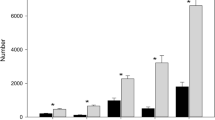Abstract
On 17 field plots of 0,25 to 1 ha in forest plantations of southern Germany various commercial baits containing zinc phosphide, chlorphacinon and diphenacoum were tested in a pilot study for control of harmful small rodents likeMicrotus agrestis, M. arvalis andClethrionomys glareolus. The baits were dispersed in different concentrations over the ground or alternatively they were put together with a piece of apple in bait stations. The animals in the field plots were trapped by means of live traps, marked and released. The efficacy of the treatments was tested by repeating this procedure in consecutive time intervals and by analysing the fractions of marked and unmarked specimens. In comparision with a disperse distribution of the unprotected baits over the ground surface better results and a more lasting success could be mostly obtained with only 9 earthenware pipes distributed over one hectare and filled with a small amount of baits together with a piece of apple. The advantages and disadvantages of the bait station technique are discussed. It is assumed that the efficiency of the bait station technique can be improved by means of attractants and pheromones.
Zusammenfassung
Auf insgesamt 17 Versuchsflächen wurden Begiftungsversuche mit verschiedenen Köderpräparaten und unterschiedlicher Ausbringungstechnik durchgeführt. Neben der praxisüblichen breitwürfigen Ausbringung wurden die Köder auch konzentriert in Kunststoffbechern oder Tonrohren zusammen mit einem Stück Apfel als Lockmittel ausgelegt. Insgesamt waren die Bekämpfungserfolge sehr unterschiedlich und deshalb noch unbefriedigend. Ganz allgemein war die Wirksamkeit bzw. die Annahme der Giftköder vom gesamten Nahrungsangebot abhängig. Erst bei Nahrungsmangel wurden die Köder in größerem Umfang angenommen. Bei der Verwendung von Ködern mit blutgerinnungshemmenden Wirkstoffen wurden bei der konzentrierten Ausbringung längerfristig etwas bessere Ergebnisse mit einem geringeren Mittelaufwand erzielt als bei breitwürfiger Verteilung der Köder. Bei der Verwendung von Köderstationen erscheint die Verwendung von Lockstoffen und Pheromonen erfolgversprechend.
Similar content being viewed by others
Literaturverzeichnis
Bäumler, W., Hohenadl, W., 1980: Über den Einfluß alpiner Kleinsäuger auf die Verjüngung in einem Bergmischwald in den Chiemgauer Alpen. Forstwissenschaftliches Centralblatt99, 207–221.
Blower, G., Cook, L., Bishop, J., 1981: Estimating the size of animal populations. George Allen & Unwin Ltd., London, Boston, Sydney, 128p.
Frank, F., 1952: Umfang, Ursachen und Bekämpfungsmöglichkeiten der Mäusefraßschäden in Forstkulturen. Nachrbl. f.d. Dtsch. Pflanzenschd.4, 182–189.
Hansson, L., Zejda, J., 1977: Plant damage by bank voles (Clethrionomys glareolus [Schreber]) and related species in europe. EPPO Bull.7, 223–242.
Hood, G., 1972: Zinc phosphide—a new look at an old rodenticide for field rodents. proc. Vth. Vertebr. Pest Confer., 85–92.
Lauenstein, G., 1979: Zur Problematik der Bekämpfung von Feldmäusen (Microtus arvalis) auf Grünland. Zeitschr. f. angew. Zool.66.
Myllymäki, A., 1975: Outbreaks and damage by field rodents and other harmful small mammals in Finland. InHansson, L., Nilsson, B.: Biocontrol of rodents. Ecol. Bull. Stockholm NFR19, 17–37.
Oepp-Eppo, 1974: Guide-lines for the development and biological evaluation of rodenticides. Organisation europeene et mediterraneene pour la protection des plantes 49 p.
Radvanyi, A., 1974: Survey and control of small mammal populations on two hardwood plantations in southern Ontario. Forest chronicle50, 181–185.
Schindler, U., 1954: Mäusseschäden und Mäusebekämpfung in Niedersachsen während der Erdmausmassenvermehrung 1951–1953. Forstw. Centralbl.73, 240–251.
Turcek, F., 1967: Ökologische Beziehungen der Säugetiere und Gehölze. Bratislava, Vydavatel'stvo Slovenskij akademie 210 p.
Author information
Authors and Affiliations
Additional information
Mit 4 Abbildungen und 1 Tabelle
Rights and permissions
About this article
Cite this article
Bäumler, W., Fuhrmann, H., Lichtenwald, G. et al. Erfahrungen mit verschiedenen Ködermitteln und unterschiedlicher Ausbringungstechnik zur Bekämpfung forstschädlicher Wühlmäuse. Anz. Schadlingskde., Pflanzenschutz, Umweltschutz 56, 1–6 (1983). https://doi.org/10.1007/BF01903252
Issue Date:
DOI: https://doi.org/10.1007/BF01903252




